سازمان نام های جغرافیایی ایالات متحده آمریکا یک بار دیگر طی بخشنامه ای بر کاربرد صحیح نام تاریخی خلیج فارس در کتابها و مکاتبات و نقشه های عمومی تاکید کرد.
United States Board on Geographic Names
Foreign Names Committee
Statement Regarding the US Board on Geographic Names’ Decision on the Name ‘Persian Gulf’
The US Board on Geographic Names (US BGN) is aware of regional and national sensitivities
associated with the name of this geographic feature, and with similar toponymic issues in many
parts of the world. The basis for the US BGN’s decision on the name ‘Persian Gulf’ rests on two
of the Board’s policies covering the selection of standard names in areas outside of the United
States.
The first policy addresses selection of standard names for high seas features, i.e., bodies of water
and maritime features that contain area beyond the sovereignty of a single nation. Board policy1
states that a single conventional name, if one exists, will be chosen as the standard name for such
features for official use in US Government publications.
The second policy covers the selection of a conventional name, defined as an English-language
name in widespread and current usage. Qualification of an English-language name under the
criterion of “widespread and current usage” is determined by consulting, among other sources,
the latest editions of the various print and online English-language geographic references.
In applying these policies to the case of the subject high seas feature, the Board’s Foreign Names
Committee has determined that the longstanding BGN-approved name ‘Persian Gulf’ is still the
appropriate standard name for use in official US Government publications.
In 1993 the BGN Foreign Names Committee did not approve a proposal from US Central
Command to change the name ‘Persian Gulf’ to ‘Arabian Gulf.’
Use of the term ‘Arabian Gulf’ is acceptable when communicating informally with Arabicspeaking
military and government partners in the region. This name may also be used in internal
memoranda and other communications not destined for a public audience. If the name ‘Arabian
Gulf’ is used in internal-use graphics the following disclaimer should be included:
“’Persian Gulf’ is the name approved by the U.S. Board on Geographic Names for the
water body labeled ‘Arabian Gulf’ on this graphic.”
However, in comments to the press, and in maps and reports reflecting the U.S. Government
positions, policy dictates use of the BGN-approved name ‘Persian Gulf’ only.
۱ Maritime Features policy approved 29 November 2005. APPROVED by e-mail vote 29 March 2013.
UNGEGN:
A glance at the Historical, Geographical and Legal Validity of the term : Persian Gulf
Nomenclature:Persian Gulf .
C
Persian Gulf in Historical texts and Documents.
Persian Gulf in all Historical Maps of the region
•
For the first time in 1971 in a UN text wrong term was used and then was corrected by a UN instruction and Note No. AD311/1GEN dated March 5, 1971.
From among the other instructions of United Nations, the following samples can be named:
· Note No. LA45.82 dated Aug. 10, 1984 (New York)
· Circular No. CAB/1/87/63 dated 16.02.1987 of Managing Director of UNESCO.
· ST/CSSER/29 dated Jan. 10, 1990.
· AD/311/1/GEN dated March 5, 1991.
· ST/CS/SER.A/29/Add.1 dated Jan. 24, 1992.
· ST/CS/SER.A/29/Add.2 dated Aug. 18, 1994.
· ST/CS/SER.A/29/Rev.1 dated May 14, 1999.
Translated and abstracted from the book:
“Documents on the Persian Gulf‘s name ancient heritage for all the time”. By : Dr.Mohammad Ajam. December 2007
The Persian Gulf and its equivalent in different languages has been in used continuously since 2500 years ago in all languages and all over the world specially in the Arab world so that Befor 1960s not even a single case of calling “the Gulf ” as the Arabian gulf been found in any text or map specially in Arabic language.
for the first time the new name was appeared in 1960s pan Arabism era.Not only ancient and past centuries texts and contracts but also all international organization and institutions also uses and recognize the termPersian Gulfas the valid term.
Below are Some Historical, Geographical and Legal Validity of the Nomenclature: Persian Gulf .
Introduction
The importance of the geographical names had been considered by geographers since ancient times. Through maps, atlases, and books, thePersian gulf’s name had been protected during different eras as a part of historical, cultural identity and saved as intangible heritage. For the same reason, any change, destruction, or alteration of the such unique names registered in historical deeds and maps is like the destruction of the cultural heritages. Therefore, the names of geographical features profiting from a common unique historical identity, should not be utilized as political instruments in gaining a political, tribal, and racial objective.
ThePersian Gulfas the most ancient commercial naval path is located in the southwest of the Asian Continent separating Arabian plate from Iranian (Persian) plate with a length of 1259 kilometer and a depth of average 60m.
Name of the Persian Gulf.
Researchers and scholar, who have investigated the background of name of thePersian Gulf, became convinced of the applicability and unanimous use of the name since ancient time and at least during the past 2500 years, i.e. as of the time of the powerful Pars (Persian) Empire. has never been seen such an unanimity in theMiddle Eastamong writers and scholars on using one name during ۲ millennium history .Considering the historical background of the name Persian Gulf, Sir Arnold Wilson mentions in his book, published in 1928 that:
“No water channel has been so significant asPERSIAN GULFto the geologists, archaeologists, geographers, merchants, politicians, excursionists, and scholars whether in the past or in present. This water channel which separates the Iran Plateau from the Arabia Plate, has enjoyed an Iranian Identity since at least 2200 years ago.
also some famous Arab scholars , historian, politician and Professor as like Mohammad Aabed al Jaaberi , Abdolhadi Altazi and Abdol Moneim Saeed Ahmad al Sarraaf and … also in separate writing or interview has mentioned as:” all the maps and written deed in Arabic had referred to the bahra or khalij fars(Persian gulf)there are no single written map or document before 1960s to refer to Persian gulf as Arabian gulf and there is no need to change of a historical name.”
Background for Application wrong term
Iran and Britain signed treaties of 19 March 1809(part5)- 1812- 1814 all have mentioned Persian gulf as an Iranian sea(Britain army will not settled in any island or coast on the Persian gulf without permission of Iran(T 1809Part5- T1812P9) but Britain breached the treaties and attacked on Khark Island in 1837, the government of Iran at that time protested to England’s colonialist policy in the PERSIAN GULF and officially warned the government of Britain to avoid mischief intended at separating the Islands of the Persian gulf which is an Iranian sovereignty sea. This warning caused the Times Journal, published inLondonin 1840, to claim the PERSIAN GULF asBritainSea, but such a name never found any place.
But following nationalization of the oil industry inIranin 1950 and dispossession of UK Companies and serving relations betweenIranandUK, the Ministry of Britain Colonies, for the first time used the incorrect name of this water body.
In these years, the Arab emirates of the South of the Persian Gulf were either colonies ofBritainor under its protectorate. To compensate its defeat, the representative of theUKin the PERSIAN GULF Roderick Owen published“The golden bubble on theArabian gulfdocumentary”.( Publisher: London, Collins, 1957.) “ blive to be agent of MI6 Spy Org. The book was immediately translated into Arabic. In his book he suggested change of thePersian gulfname to satisfy the Arabs nationalists .
:Roderick Owen wrote in the preface of his book:
“I visited PERSIAN GULF and believed that it was Persian Gulf, because I had never seen any map or deed, unless it had named the place as Persian Gulf, but by living there, I found out that the people residing at the( western) beaches are Arabs, therefore, to be polite, we should name it:Arabian Gulf.”
It is very clear that Owen was wrong. Even if he was correct it can not be a good excuse to change a historical name of an international waterway. Even now all original Arabs citizen of the 6 Arab state of GCC are less than population ofTehran. If the population or number of the countries around a sea is a criteria to change the historical name of the Persian gulf with 2500 years continuously in used then why the Indian and Pakistani shall keep the name of encircled sea around them with the current name of Arabian sea?! So Indian and Pakistani are entitled to change it to Mokran orUrduSEA. Or African countries should changeIndian Ocean. But that is not the rule or criteria the rule shall be decided by UNCSGN and UNGEGN.
In 1960, after Iranand Egypt’s disconnection of relationships and after the Arab-Israeli war, anti Iranian actions culminated due to the SHAH’s support ofIsrael. in a congress of Baas Party inDamascus1970, participating heads demanded for change of the name ofPersian gulfto a nationalistic , without .
relying on any legal and historical document.
The Name of Persian Gulf in Historical texts and Documents.
Few written deed has remained from before the Persian (Pars) Empire, but in the oral history and culture, the Iranians have called the southern waters ofPersiaat that time asAjamSeaand IranSeaand Pars sea.
During the years: 559 to 330 B.C. coinciding with the sovereignty of the Persian Empire over the most part of the Middle East area , especially the whole part of the Persian Gulf and some parts of the Arabian Peninsula, the name of Pars ( Persian) Sea has been widely written in the compiled texts of the different era.
In the travel account of Pythagoras, Darius sent Scylax to survey the Persian sea. several chapters are related to the description of his travels accompanied by Dariush I, toSusaand Perse polis, and the area ofPersian gulf is described.
From among the writings of others in the same period, there is the inscription and engraving of Darius the Great, which belongs to the 5th century BC where, Dariush Shah , the emperor of Persian (Pars) Empire has mentioned the PERSIAN GULF Water Channel as PARSSEA, in the Hecataeus maps(472 to 509 B.C.) Persian Gulfdescribed .
In the world map of Niark Niarjous (285-347 B.C.), Persian Gulfis described. At the same time, many maps and deeds prepared up to the 8th century by the scientists and geographical researchers such as Hecataeus, Herodotus, Hipparchus, Claudius Ptolemy, Krats Malous and in the Islamic period, also Tabari- Mohammad Ibn Mousa Khwarazmi- Abou Abu Yusef Eshaq Kindi, Ibn Khardazabeh – Batani, Masoudi (Masudi), Abou Zeyd Balkhi, Estakhri, Ibn Houghal (Ibn-e Hawqal), Aboureyhan Birouni (Biruni) and others, had explained the Persian gulf and saing that “ there is a wide sea at south of Iran named Pars Sea, (Persian), Bahre Fars, Sinus Persicus and Mare Persicum and so on.
In a book, named travels of Periplus Eritrea, the Greek ‘traveler’, of the 1st century A.D. has called the Red Sea as Arabian Gulf; the Indian ocean has been named Aritra (Eritrean) Sea; the waters at Oman Coast is called Pars Sea; Barbarus region (betweenOmanandYemencoast said to belong to Persian (Persia), and the Gulf located at south side ofIran(to the south of) is named: PERSIAN GULF. also the residence of Persians living at both sides of thePersian gulfhad been confirmed .
:Islamic era
There are no any written document about Arabian coast prior to prophet Mohammad era. However, in more than 300 geographical, historical, literary, books or interpretation(Tafsir) of quran and Islamic morals, and jurisprudence, the Muslims and Arab scholars have described PERSIAN GULF from beginning day of Islamic period to the last century .from Tabari (1100 ac)to tantavee(1900) all Islamic scholar and religious leader in the different era ABAASID- FATOMID – MUGUL- OTHEMAN – SAFAVID ERA ALL unanimously had referred to it as Persian gulf or Persian sea .
Hegemony of Portuguese in the Persian gulf
In 1507 A.D.Portugal’s navy capturedHormuzIslandunder commandment of Alphonso Burkerk and it continued till 1620. In a research essay, Dr. José Manuel Garcia, professor and a member of Geographical Society of Portugal emphasized the name of Persian Gulf in the official and unofficial deeds and maps ofPortugalsince 1507 so far. The maps prepared by the Portuguese onPersian Gulfare kept in museums as mankind heritage.
From among 50 maps and letters exchanged during the years: 1500 to 1700
A.D. among the governors of Persian Gulf and the kings ofPortugaland
Spainor those mentioned in books and writings of tourists,Persian Gulfhas been named as follows:
Mare de Persia, Persico Sinus, mare Persio, Mare Persicum, Mar Persiano,
Persiski Zaliv, Persischer Golf,ParsSea, Bahre Fars, Perza obol, Persiste Habbugt.
Persian Gulf in arabs Contracts and Accords
As of 1800 to 1970, at least in 45 contracts concluded among the tribal leader(Emirates) or countries such as Kuwait, Saudi Arabia, Ottoman, Oman, Emirs of Motesalehe (United Emirates), compiled in English and Arabic, the name of Persian Gulf(bahre fars) has been used.
In a book published in UAE 1989 by Rashed Ali Mohammad titled : ((Economic and political agreement between the Arabs Emirs and Britain 1806-1971)) he had included original of around ۲۲ contracts in all of them in both Arabic and English text the name of Persian gulf had been mentioned.
:From among the aforesaid contracts the following can be mentioned:
۱٫ General contract with Arabian Emirs on Jan. 8, 1820 between Sheikhs of United Emirates atPersian Gulf, signed by General Cair and 11 chiefs of Arab Tribes, the word: Al khaleej Al Farsi has been used in the Arabic texts.-
۲٫ Treaty of 1856 and ۱۹۴۷ on Prohibition of Slaves trades.-
۳٫ Permanent Contract of Peace in 1853.-
Contract on Independence of Kuwait (this deed was registered on June 19, 1961 with Secretariat of United Nations.
Treaty on Determination of Border Lines ofIraqandKuwait(1996)-
Even Nasser the pan Arabic leader of Egypthad used the term of (al khaleej al Farsi) Persian gulf in all his speeches and his books and articles before war 1967.
Persian Gulf in all Historical Maps of the region
In all the important historical maps and Atlas whether modern or belonging to previous centuries, the water artery located at south ofIranhas been registered asPersian Gulf. In the Arabian countries too, it has always been namedPersian Gulfup to the 70s. For instance, in the Atlas “Al araq fi Al khavaret Al ghadimeh” by Dr. Ahmad Souseh (Baghdad 1959) including 40 maps among the Arabian sources of the Middle Ages all have the Arabic term for the Persian gulf.
In the maps presented by Arabian countries to the International Court of the justice for settlements of border claims, the name ofPERSIAN GULFhas been mentioned in their documents.
– Atlas of La Péninsule Arabique dans les cartes Européennes Anciennes (The Arabian Peninsula in Old European Maps).Paris, Monde Arabs institute and Tunisia university IMA & Khaled. Al Ankary, 2001. ۴۲۴ pp. contains ۲۶۰ maps with details about each map in 3 languages: Arabic, English and French. Almost all of these 260 maps have the correct name of Persian Gulf.
Moreover, 10 maps have used both Persian Gulf for the gulf and also persian Sea (for the current area of Seaof Oman and Arabian sea) •
The book: Roots of Kuwait. “Osoul Alkuwait Almanshour Alalam” (1991) published in theNetherlandsalso contains 15 maps where the name of PERSIAN GULFexists.
- In the “Atlas of Alkuwaitfi Al kharaet Al Aalam” some maps have been used where there exists the name ofPERSIAN GULF.
In Atlas of “Alkuwaitfi Al kharaet Al tarikhieh” published by the efforts of Abdollah Yousef Al ghanim in 1994, there are about 200 maps mentioning the name ofPersian Gulf
- In the ARABIC book: “Al khalij al fars Abar Al tarikh va Al ghoroun” (written by Mohammad Mirza, 1976Cairo) there are 52 maps drawn out of Arabic sources, all have the name ofPersian Gulf.
- In Atlas of “History of Islam” (1951-55AmericaandEgypt) the namePersian Gulf has been mentioned IN ۱۶ MAPS.
- In the Atlas of “Khalij (Gulf) in the Historical Maps” published in UAE (۱۹۹۹) more than 600 maps have the term Persian gulf.
- The Arabic Bank and Beyt Al quran inBahrainpublished a large wall calendar in 1996 containing the 11 historical map ofBahrainin which all the maps contain the name ofPersian Gulf
It is interesting that from among 6000 existing historical maps published up to 1890, there are only three maps mentioning the names of Basreh Gulf, Ghatif Gulf, and Arabic Gulf, this name in fact are the name of bays of the Persian gulf. in local language they call the bay also as the gulf like :gulf of Busher-ChahBahar Gulf,SirafGulf,BasrehGulf,Ghatif Gulf,Bahrain Gulf, Basre gulf …. but such names are not applied to the entirety of the Persian Gulf.
It is obvious that the promotional use by the Arabs of the three aforementioned maps, whose identity and originality are not clear, in comparison with 6000 maps and more than 300 historical and credible geographical books from ancient time to 20thcentury , shall lack any value.
In the Arabic Dictionaries like Al Monjed, and also in all (60)Qoranic Tafsires and religious Islamic books and in all treaties ( more than 30 Arabic treaties between the Arabs tribe leader with theUKand Othman and Iranians )Persian gulfhas been used .
In the many museums all over the world some can find maps or manuscript having the name Persian gulf some recorded as intangible world heritage (UNESCO) In Library of American Congress, Britain National Library (London), deeds at Ministry of India’s Affairs (London), Library of Faculty of Orientals Studies of London, there are more than 300 maps, containing the name Persian Gulf. In Eskandria Library of Egypt And National Musum Of Egypt alsoPersian gulfmap are preserved.
Furthermore, about 30 valid Atlas have registered the name ofPERSIAN GULFwithin the past 300 years, such as: Atlas of Thomas Herbert (1628).
– Atlas of Pars,LousajUniversity(1863). – Atlas ofGermany(1861), Pars Envile Atlas (1760).- Atlas of Modern Geography (1890).- Atlas of London (1873),- Atlas of Ernest Embrosius (1922),- Atlas of Bilefild (1899)- Atlas of Harmsorth (19th Century, London). – ….
In 18th to 20th centuries when theUKexpanded its dominance over the seas and appeared as protectorate of the Sheikhs on the south sectors of the PERSIAN GULF, the official maps and documents of the areas in all languages refers to the GULF asPERSIAN GULF.
Applications of the Name Persian Gulf by International Organizations
Not only the Persian Gulf had been used since ancient time in all languages but also in current time non Arabs countries had never recognized a new tribal name and UN and all international Organizations and affiliated foundations have applied the correct name of PERSIAN GULF.
In the Arabic text of the UN some time had appeared wrong term but as soon AS the secretariat have considered it the correction have been done.
For the first time in 1971 in a UN text wrong term was used and then was corrected by a UN instruction and Note No. AD311/1GEN dated March 5, 1971.
From among the other instructions of United Nations, the following samples can be named:
· Note No. LA45.82 dated Aug. 10, 1984 (New York)
· Circular No. CAB/1/87/63 dated 16.02.1987 of Managing Director of UNESCO.
· ST/CSSER/29 dated Jan. 10, 1990.
· AD/311/1/GEN dated March 5, 1991.
· ST/CS/SER.A/29/Add.1 dated Jan. 24, 1992.
· ST/CS/SER.A/29/Add.2 dated Aug. 18, 1994.
· ST/CS/SER.A/29/Rev.1 dated May 14, 1999.
In all the above mentioned notes and circulars, it has been instructed that the water body existing at the south side ofIranbe stated:PERSIAN GULF. The Specialized Group for Experts on Standardization of Geographical Names,(UNGEGN) active in the United Nations Social Economical Council also emphasizes the correct use of historical names for features, and is active in dispute settlement related to geographical names. “Naphtali Cadman” the head of Working Group for Toponymy Information has stated in a book published by UNGEGN on 2001 that the motivation to change the name ofPERSIAN .
** Some of the most important historical atlases of the persian gulf are as:
- ۱- Atlas of The Arabian Peninsula in Old European Maps (253 maps) by Khaled Al Ankary, Institute du Monde Arabe,ParisandTunisiaUniversity,2001
all 253 maps of this atlas has been printed in color and 3 languages and have the corect name of Persian gulf also the maps in pages:-141-226-323-322-331-345-347-363-355 have mentioned persian gulf for the Gulf and also persian sea for the body of water of current and Oman gulf , such as the hours shape map of Bunting H.S.Q34/24CM Hanover,1620.
۲- Atlas of Historical maps of the gulf by sultan muhammad al qasimi Sharjeh 500 maps of the persian gulf .
- ۳- Atlas ofIraqin old maps. by Ahmad Sussa 39 old maps of arabic and islamic sources all have the correct name of persian gulf(Bahre Fars)
- ۴-Kuwaitin the maps of the world 1992 . contan 80 maps all have thePersian gulfname.
- ۵-Kuwait reading the historical maps, 200 maps ,1994 .
- ۶-Roots ofKuwait, 15 maps ,1991.
- ۷-description of thePersian gulfin the historical maps by Iranology foundation, 40 maps of Islamic scholars and 120 maps of European famous cartographers 0f1500-1900 AD.by DrHassan Habibi 2007.
Tehran.all the maps have the name persian gulf. and many other atlases have also been published and they have been described in the book: Documents on the Persian Gulf’s name .
International Organizations
and uses the Persian gulf as the international recognized term. .
written description by Muslim travelers and European geographers . Among historians, travellers and geographers of the Islamic era, many of them writing in Arabic or persian from the 9th to the 17th century, , , , Sohrab, Ramhormozi, , , Al-Mutahhar ibn Tahir al-Maqdisi (d. 966), , , , Mohammad ibn Najub Bekiran, , , , ,, , , , , and other sources have described the Persian gulf and used the terms, “Bahr-i Fars”, “Bahr-i “, “Bahr-i-Farsi”, “Dera-i-Fars”(all refers to Persia) and are equable to Persian gulf or Persian sea .
Iranian has always respected the geographical names such as for the Arabian sea although for the Arabian sea and the gulf of Oman historically other names had been used such as Mokran sea- Persian sea- Akhzar sea …
some arab scholar had wrote to justify the change of the term persian gulf they claimed that arabian gulf also had been used in ancien time they had mentioned pliny book . but infact pliny had never mentioned persian gulf as Arabian gulf :below is the text:
XXVIII107. Moreover in this region the sea then makes a double inroad, into the land; the name given to it by our countrymen is the Red Sea, while the Greeks call it Erythrum, from King Brythras, or, according to others, in the belief that the water is given a red colour by the reflexion of the sun, while others say that the name comes from the sand and the soil, and others that it is due to the actual water being naturally of such a character. [108] However, this sea is divided into two bays. The one to the east is called the Persian Gulf, and according to the report of Eratosthenes measures 2500 miles round. Opposite is Arabia, with a coastline 1500 miles in length, and on its other side Arabia is encompassed by the second bay, named the Arabian Gulf; the ocean flowing into this is called the Azanian Sea. The width of the Persian Gulf at its entrance some make five and others four miles ; the distance in a straight line from the entrance to the innermost part of the Gulf has been ascertained to be nearly 1125 miles, and its outline has been found to be in the likeness of a human head. [109] Onesicritus and Nearchus write that from the river Indus to the Persian Gulf and from there to Babylon by the marshes’of the Euphrates is a voyage of 1700 miles.
: Translated and abstracted from the book:
Do : the eternal heritage of ancient time
Also :
- United Nations Group of Experts on Geographical Names , 23rd Session,Vienna, 28 March – ۴ April 2006. accessed October 9, 2010
- documentary on the persian gulf history
- a historical documentary on the name ofPersian gulf
- documentary on persian gulf
[]
- Documents on thePersian Gulf’s name : the eternal heritage of ancient time
Author: Ajam, Muḥammad. و documentary on the name Persian gulf .
– راشد، علىمحمد. الاتفاقات السیاسیه و الاقتصادیه التى عقدت بین الامارات ساحل عمان و بریتانیا (۱۸۰۶ – ۱۹۷۱)، منشورات اتحاد کتاب و ادباء الامارات، ۱۹۸۹
- Bosworth, C. Edmund. “The Nomenclature of the Persian Gulf.” Pages xvii-xxxvi in Alvin J. Cottrell (ed.), The Persian Gulf States: A General Survey. Baltimore: Johns Hopkins University Press, 1980.) (pg xxxiii).. Excerpt: Not until the early 1960s does a major new development occur with the adoption by the Arab states bordering on the Gulf of the expression al-Khalij al-Arabi as weapon in the psychological war with Iran for political influence in the Gulf; but the story of these events belongs to a subsequent chapter on modern political and diplomatic history of the Gulf.
- , retrieved 24 Feb. 2009.
- ALAI, CYRUS. . Encyclopædia Iranica. Retrieved 2012-02-01.:
After World War II, some circles decided to change the name of the Persian Gulf to Arabian Gulf. Although the government of Persia opposed the move vehemently, in some editions of a few maps and atlases the term Persian was omitted, leaving only “The Gulf” (e.g., The , p. 39), while the historical term Persian Gulf mostly remained intact, as in the (p. 77;
NAME OF A CAIRO STREET PERSIAN GULF. fig. 7).
.
- Gerard Mercator (۱۵۴۱) via harvard.edu
- Gerard Mercator (۱۵۶۹) via wilhelmkruecken.de
- Abraham Ortelius (۱۵۷۰) via cartographicarts.com
- Republic of Turkey Ministry of Culture and Tourism www.kultur.gov.tr
- United Nations Group of Experts on Geographical Names (April 2006).
- ,Documents on the Persian Gulf’s name : the eternal heritage of ancient time Author: Ajam, Muḥammad. retrieved 24 Feb. 2012.
- ,Conspiracy to change a heritage name: “The Persian Gulf”2002 by M.Ajam, retrieved 24 Feb. 2012.
- ,Documents on the Persian Gulf’s name : the eternal heritage of ancient time Author: Ajam, Muḥammad. retrieved 24 Feb. 2012.
- .
- (PDF).
- (PDF).
- Report of the United Nations Group of Experts on Geographical Names on the work of its twenty-third session. Document E/2006/57, Economic and Social Council, United Nations. New York, 2006.
- . International Hydrographic Organization. 1953. Retrieved 6 February 2010.
- . CNN. 24 January 2008. Retrieved 22 May 2010.
- Spencer, Richard (23 February 2010). . The Daily Telegraph (London). Retrieved 22 May 2010.
- ,IRIB,
.
- ,IRIB,
- Arabian documents on the persian gulf:
- ‘arab’s documents on the persian gulf
- در
- فیلم کامل مستنداسناد نام خلیج فارس
- فیلم مستنداس
The Persian Gulf: Historical, Geographical and Legal Validity of the Name
Monday, 29 November 2010 By: United Nations
United Nations*
[Note: In recent years the historic nomenclature ‘Persian Gulf’ has been contested by the Arab countries which at times denote this region as Arabian Gulf. In the light of this, some have settled for an unhistorical non-prefixed ‘Gulf’ to denote the body of water between the Arabian Peninsula and Iran. In the light of the controversy, the 2006 UN report prepared by a panel of experts regarding the nomenclature is reproduced here as an Occasional Paper. Editor, MEI OP.]
Also :
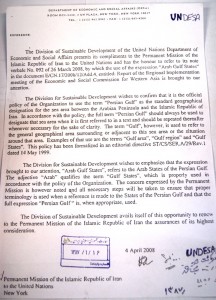
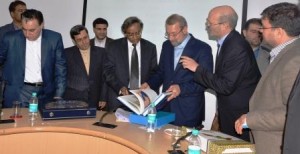

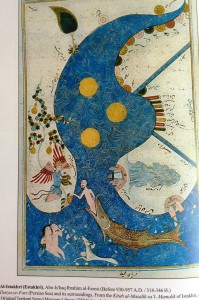

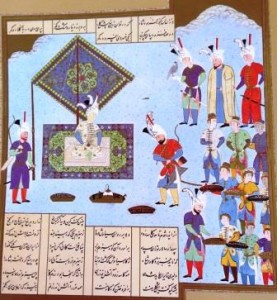

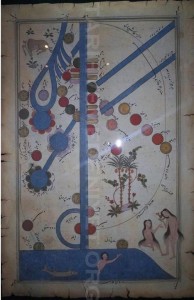
آخرین دیدگاهها